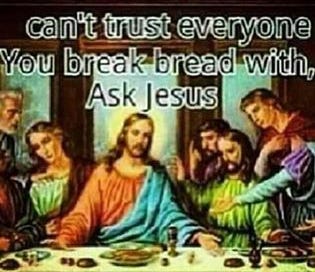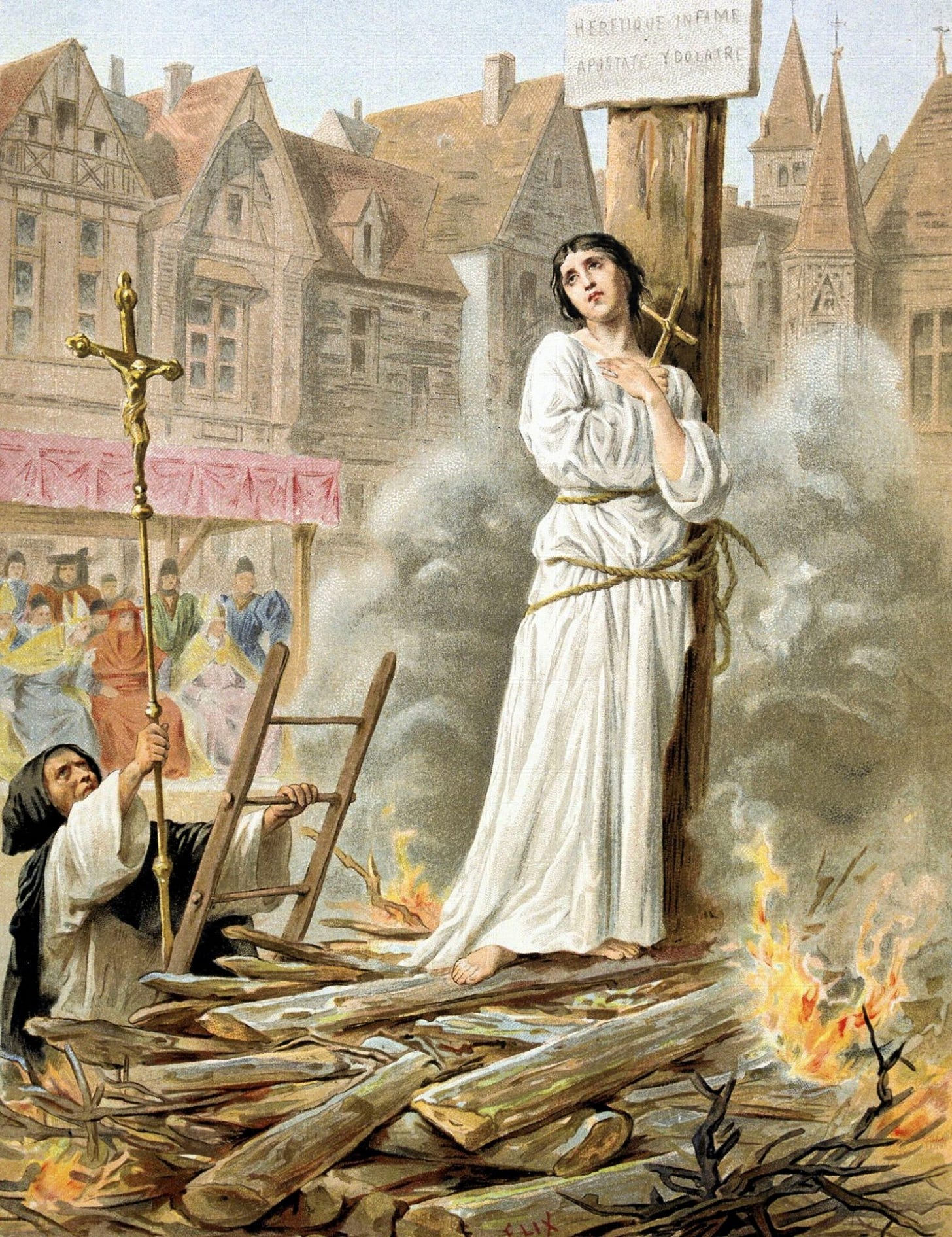While they were eating, Jesus took bread, and when he had given thanks, he broke it and gave it to his disciples, saying, “Take and eat; this is my body.” Then he took a cup, and when he had given thanks, he gave it to them, saying, “Drink from it, all of you. This is my blood.—Matthew 26: 26-28
Just as the latter daze buzz phrases “Trust the Science” and “Trust the Plan” were slogans employed to shame people from questioning whether their antecedents, covid and QAnon respectively, held any true weight—here’s a hint, they didn’t—so too the Mysterium Fidei or “Mystery of Faith,” whose original inclusion in the Eucharist (the central sacrament of the Catholic Faith1) is itself a mystery.
But then there was the weird little phrase found towards the end of the institution narrative, in the words [Jesus spoke] over the wine…the words mysterium fidei are sort of stuck in the middle of this sentence. They have no scriptural lineage, and were added to the words of Jesus only in the Roman church, sometime around the year 500.2
Wait a second… there was “no scriptural lineage” and they “were added to the words of Jesus,”3 meaning the Church fathers some time around 500 AD had put words in Jesus’s mouth? Though it was not Dr. Byers intention to expose the Church lying about what they were teaching as Divine Revelation, it is, nevertheless, what he did and I thank him for it because it gives me something to base my argument on. Though many will shrug this off as trivial, their poopooing does not erase the logical question, “What else did the Church fathers add, change and/or subtract from what they were pawning off as the Gospel truth back then?”
Well, there is the massive lacuna of the Gnostic Scriptures that the Church declared heretical sometime around AD 180 and that were almost totally eradicated from the burgeoning orthodoxy sometime in the 5th century. I guess you could start with that! But the Magic Eight Ball I’m consulting guides me to “Better not tell you now.” So I won’t…at least not yet. Better to build a case on the “why” of the sneaky Church fathers’ bad faith inclusion of “mysterium fidei” which, if one is being honest, was not very “Christian” of them.
For one, before the Council of Nicaea, Christianity had a dueling set of creeds: orthodox emphasized faith [fidei] and the gnostics emphasized their namesake gnosis, which in Greek means knowledge. Even though the gnostics had been declared anathema by the dominant orthodoxy for several hundred years by then, I conjecture the Church fathers inserted “Mysterium Fidei” in Jesus’s mouth to give the stamp of divine approval to their mode of redemption through faith, and to obscure, stamp out and replace the gnostic’s idea of redemption through knowledge that, mayhap, was still lingering in the collective unconsciousness of their congregations.
Though it would take another 1500 years to put a name on the psychological phenomenon, I doubt human nature was so much different that the Streisand effect4 was not in some ways in effect back then. Just because you banish an idea doesn’t mean it’s magically erased from people’s memories, and often the attempt to censor something on an industrial scale makes its remembrance all that much more poignant and, dare I say, keener, leading to the unintended consequence that, in the minds of those commanded to “Just forget it!,” the urge to partake of that which was forbidden becomes nearly irresistible.
Anyway—more on that forbidden [fruit] thing later—what better way to put the nail in the gnostic coffin than put the logos (Multi-Word Utterance, Tradition, Explanation, Theory, Expression) of “Mysterium Fidei” in the mouth of the Logos, meaning the Incarnate God and numero uno salesman of the Church father’s budding business enterprise? It’s a no brainer. It’s a neon sign flashing HAVE FAITH! combined with the most profound miracle5 pulled off by “Jesus, the Son of God:” turning the wine to blood and the bread to flesh during the Last Supper, promulgating the most holy priestly rite of Transubstantiation.6
Maybe the Eucharist, “most precious possession which the Church [has had] in her journey through history,” according to Pope John Paul the 2nd7 and the spurious addition of the “Mysterium Fidei” were a one-two punch by the early Church fathers to knockout the gnostic heresy that had been an albatross around their necks since they’d declared it anathema, around the middle of the second century, once and for all.
Nobody knows for sure, but it’s a reasonable supposition, an intuitive application of knowledge gleaned from the available history. History, as everybody knows, is written by the victors. The victors, inevitably were the orthodox Christians, who it’s already been shown were not above perverting Divine Revelation, putting words in Jesus’s mouth that, according to the apostolic record, were words he never said.
Having a spiritual set of leaders founded upon a creed that overcame it’s main competitor by skullduggery and deceit…I don’t know, but doesn’t it kind of call into question the integrity of its whole foundation? Could be debatable I suppose, but what is not in question is that their modus operandi is indicative of every group of TPTB that have lorded power over people from time immemorial: coercion and trickery with an overwhelming monopoly on the use of violence.
Marrying the unquestionable deity to the word that guaranteed their hegemony—faith—by emphasizing its “mystery” and making it speak through an all-seeing, all-knowing God then making themselves the intermediaries between the plebes and this ineffable, unknowable supernatural power made accreting and maintaining power easiy as a jiujitsu master locking in a rear naked choke on a toddler.

Or a baby, even. It was no-contest and ethically execrable, but “Might Makes Right,” especially if you’re angling to be top dog in a fallen world; regardless of if you’re business model is redemption through peace, love and understanding.
Ye of little faith, please…if you ain’t cheatin’ you ain’t tryin’! Faith just means trickle down blind obedience to the Deity through its proxy the Church fathers and the clerical bureaucracy they installed in their society to control the plebes. Sure, all you need is love, but absolute authority and an army doesn’t hurt your chances of keeping the heretics in line either, to the tune of 1055 degrees.

Who says Christian’s can’t be extremists? Anne Hendrick, Joan of Arc and the tens of thousands of heretics burned alive, hanged and tortured to death down through the ages by these men of god in the diamond-shaped hats would beg to differ.
Strikingly, in the case of Joan of Arc…
…her most serious crime was the claim of direct inspiration from God; in the eyes of the court this refusal to accept the church hierarchy constituted heresy.8
Although Joan of Arc was, by dint of her posthumous and supremely ironic9 sainthood a next-to-perfect-as-humanly-possible-perfect-can-be Catholic, her claim to Divine Revelation is/was reflective of the gnostic concept of the “divine spark” that implies that every human has within them a direct connection to God; a concept that, regardless of the accused’s religious affiliation, could not be countenanced by an institution whose very existence relied on its ability to keep an iron grip on its monopoly on Divine Revelation, thereby convincing the plebes that the only way to commune with God and the only way was through having faith in the Church fathers’ hierarchy to guide you to heaven.
The alternative in this hellish system?
Burn in hell for all eternity.
And if you’re a bit too uppity, a bit too full of “blasphemous presumption,” the Church will hasten your damnation by tying you to a stake and then burning you alive in what they barbarically refer to as “purifying flames.”
Can you say “absolute power?” And by now, we should all know where that leads! Jeez. And to bolster this contention and put a cap on the Joan of Arc saga I leave you with this excerpt from the Encyclopedia Britannica:
…it took two days for Joan to answer the 70 charges that had been drawn up against her. These were based mainly on the contention that her behavior showed blasphemous presumption…Perhaps the most serious charge was of preferring what she believed to be the direct commands of God [direct divine intervention] to those of the church.10
Even though it is in Christianity’s prospectus to forgive and forget, you really ought to take heed of the institution’s brutal history of mayhem and deception, and ask yourself whether these are really the kind of people to whom you want to entrust the disposition of your immortal soul. Much less wondering whether you could stomach going back in time and having a beer with them, or perhaps a goblet of mystic heated wine? The answer should be a resounding, “Hell nah! I don’t think so, Holmes.”
And for those of you who shrug your shoulders and declare: C’mon, that was hundreds of years ago…things have changed, how do you explain the genocide in Gaza that the whole world—except for its Israeli perpetrators and their American enablers—can clearly see?
Well, I’ll tell you.
A large swath of Christians throughout the country and an overwhelming concentration of the shot-callers in DC, are blinded by their faith in those who they perceive as “God’s Chosen People” and their strong delusion that the only way to gain salvation is through the fulfillment of apocalyptic prophecies. Never in my lifetime, it seems, have there been so many who have eyes, but refuse to see.
United States Conference of Catholic Bishops
The Eucharistic Prayer is the heart of the Liturgy of the Eucharist. In this prayer, the celebrant acts in the person of Christ as head of his body, the Church. He gathers not only the bread and the wine, but the substance of our lives and joins them to Christ's perfect sacrifice, offering them to the Father. …etc. etc.
https://www.usccb.org/prayer-and-worship/the-mass/order-of-mass/liturgy-of-the-eucharist
Oregon Catholic Press, Liturgy of the Eucharist by Dr. Glenn Byer
https://www.ocp.org/en-us/blog/entry/mystery-of-faith-mysterium-fidei
EDITOR’S NOTE: Dr. Byers’ inclusion of “only in the Roman church” is a misleading and generally unnecessary distinction because the Roman church was, for all intents and purposes “The Church” of that time. see Constantine the Great, Edict of Milan, Pope Leo
Psychology Today: Understanding the Streisand Effect, Dec. 20, 2019
In 2003, a picture of Barbra Streisand’s beachfront home hit the web as part of a public collection of images displaying coastal erosion. In response, in February 2003, Streisand sued the photographer for $50 million for invasion of privacy, claiming violation of a state law aimed at the telephoto lenses of paparazzi.
Ironically, the media attention surrounding the lawsuit made the photo of her house go viral (at least in 2003 terms). In the month before the lawsuit, the picture had been downloaded only 6 times, including twice by her lawyers—whereas the image was downloaded more than 420,000 times during the month following the lawsuit. This paradoxical result—where an attempt to silence, suppress, or stop something backfires—was dubbed the Streisand effect….
Encyclical Letter of His Holiness Pope John Paul II, Apr. 17, 2003
The Church draws her life from the Eucharist. This truth does not simply express a daily experience of faith, but recapitulates the heart of the mystery of the Church. … The Second Vatican Council rightly proclaimed that the Eucharistic sacrifice is “the source and summit of the Christian life”. “For the most holy Eucharist contains the Church's entire spiritual wealth: Christ himself, our passover and living bread. Through his own flesh, now made living and life-giving by the Holy Spirit, he offers life to men.”
https://www.vatican.va/content/john-paul-ii/en/encyclicals/documents/hf_jp-ii_enc_20030417_eccl-de-euch.html
Catholic Answers Magazine: Transubstantiation for Beginners, 7/1/1993
—…“The blessing-cup that we bless is a communion with the blood of Christ, and the bread that we break is communion with the body of Christ” (1 Cor. 10:16). His words are clear. The only possible meaning is that the bread and wine at the consecration become Christ’s actual body and blood. Evidently Paul believed that the words Christ had said at the Last Supper, “This is my Body,” meant that really and physically the bread is his body. In fact Christ was not merely saying that the bread was his body; he was decreeing that it should be so and that it is so. …
https://www.catholic.com/magazine/print-edition/transubstantiation-for-beginners
Encyclical Letter of His Holiness Pope John Paul II, Apr. 17, 2003
Infoplease (The Columbia Electronic Encyclopedia, 6th ed., Columbia) University: Joan of Arc-Capture and Martyrdom, 2025
https://www.infoplease.com/encyclopedia/people/history/french/joan-of-arc/capture-and-martyrdom
Editor’s Note: Consigning someone to be burned alive by a charge of heresy under your institution’s auspices, doing it and then later offering a mea culpa-whoopsie by conferring sainthood on the person “you” literally immolated to save her from the fires of hell, you have to admit, is pretty funny; not funny ha-ha but funny as in horrifically ironic. Although some dude called Going Medieval who sounds like Ted from of Bill and Ted fame offers up a most excellent apologia detailing how, owing to the political intrigues of the University of Paris faction that convicted Joan to be burned at the stake, the Catholics the author admits were “members of the Church” but, owing to their rogue status, were not “The Church” becomes a self-refutation that, far from absolving the institution, is another damning proof of its endemic corruption. However, if you wish to split hairs so that you can win a debate on X about what, at this point, is a historical technicality, I highly recommend GM’s essay: https://going-medieval.com/2023/11/17/no-the-church-did-not-kill-joan-of-arc-you-credulous-dullards/ It is very well written, excellently sourced and hella funny, but hardly compelling.
St. Joan of Arc
https://www.britannica.com/biography/Saint-Joan-of-Arc




